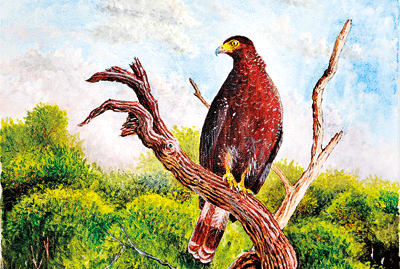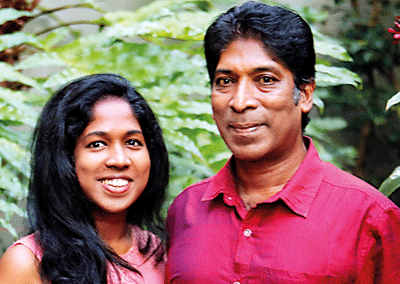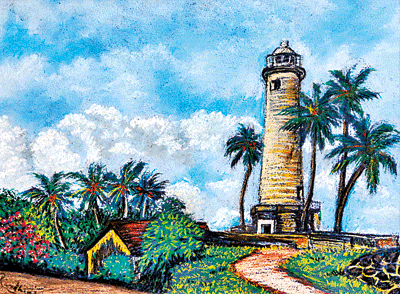A call to paint the wild

‘Master’ of all it surveys: The serpent eagle by Jayaindra
Lying on the table are many paintings – a magnificent serpent eagle surveying its surroundings, a striking sketch of palmyrah and date palms and spectacular ‘images’ of a fort as far-placed as Kalpitiya and the lighthouse at Galle.
Unwittingly, the mind races ahead giving the impression that just a stretch of the hand would allow the shiny feathers of the eagle to be felt or a closer look would bring to life the men ‘holding’ the fort behind the sturdy walls.
We are not in the wilds of Sri Lanka or even in Galle or Kalpitiya but in a home down Barnes Place looking at works of art, in a sneak preview, to be exhibited by a father and a daughter next weekend.
The painters, of course, are Dr. Jayaindra Fernando and daughter, Randhini.
Fifty-four-year-old Jayaindra dabbled in art as a boy, encouraged by both his mother and his grandmother. “Most probably my mother gave me painting stuff to keep me occupied,” he says.
Passionate about nature, he would sketch with a pencil a scene or two in his notebook whenever he was on a family trip out of Colombo, during his school vacations or on weekends, return home and put it onto an easel.
As a 16-year-old, his paternal grandmother, dubbed one of the country’s foremost naturalists of those times, Dorothy Fernando, set him a task – he had to meticulously illustrate a book on trees that she was hoping to publish.
Later school work at St. Joseph’s College, Colombo, took up all his time, but it was on a “bleak” day when he was down, having heard that he had got low marks at a test as a medical student that Jayaindra, then 21, along with fellow student Prithiviraj Fernando (now the head of the Centre for Conservation and Research based in Tissamaharama who would give up medicine later to get into wildlife research) decided to hold their first joint exhibition in 1984.

Daughter and father: Randhini and Jayaindra
They had a good set of paintings, having travelled to the canopied-Sinharaja Rainforest, the mist-clad Horton Plains, many of the National Parks and “other little, little places”.
Lounging around at home, frustrated and despondent, when the universities slipped into the turmoil of the 1987-89 youth insurrection, he once again indulged in painting which would enable the holding of his second, but this time solo exhibition in 1988.
When he sees a sight that triggers his painting passion, he sketches it there and then to catch the mood and basic outline and then gets back home to his room and paints it. Keeping a board at an angle, depending on the medium he is using and the size, he would paint to his heart’s content.
Jayaindra harks back to the time he along with his wife, Thivanshi, produced a book on ‘A selection of the fruits of Sri Lanka’. While he drew the illustrations, she did the research and their little daughter, Randhini, would toddle up to them, climb a chair and peer curiously at what her parents were up to and then do her own doodles.
Randhini loved to draw ever since she can remember and says that Thaththa exhibited a tiny little line drawing of hers at his last exhibition. She has never-ever had any formal training in art, keeping away even from art lessons at St. Bridget’s Convent, Colombo, where topics were laid down and certain ways of drawing them had to be strictly followed, as opposed to which she became self-taught.
“I wanted to be free,” she laughs, with an attraction for soft-pastels as her medium, having been handed down an “ancient” box belonging to her great-grandmother Dorothy. Sixty colours the box had and she started experimenting with them getting “addicted” to pastels.
A common question directed at her is when she would be moving into other media, but “I have fallen in love with this, though it is messy”, murmurs multi-talented Randhini, 24, who has taken up law as a profession but also finds time to play the cello for the Symphony Orchestra of Sri Lanka and is adept at handicrafts.

The Galle Lighthouse by Randhini
Comparing art to reading a good book which keeps you riveted, unable to put it down until the last page, she says that she loves to paint on a Sunday morning when it is “totally peaceful and extremely quiet”. Randhini had held her first exhibition in 2010.
For Jayaindra a third exhibition followed in 2000 but there was just no time thereafter and it is after a 17-year gap that Thaththa and his Princess are going public with their paintings together in ‘Serendib Perspectives’.
A General Surgeon at a private hospital, his work and his children have been a priority, with the indulgence in painting only during “pauses” in his busy schedule.
However, his paintings have evolved, adding a different flavour brought about by the lapse of time and he says he wants to share with Sri Lankans those valuable and important ‘sights’ for those not only unfamiliar with them but also those who may not be able to visit them.
Jayaindra talks of how they took in the vistas of Dimbulagala which are all being exhibited next week, as he scrambles to finish his 36th painting of Horton Plains which is “complex”, while his wife will handle the framing and his son, Navodith, who is an avid photographer would jog his memory on the tiny details of colour he had captured of the same scene.
| A blend of two styles | |
| ‘Serendib Perspectives’, an Exhibition of Paintings by father Jayaindra and daughter Randhini Fernando will be held on July 15, 16 and 17 from 9 a.m. to 8 p.m. at the Lionel Wendt Art Gallery, Colombo. Jayaindra’s 36 paintings on nature, wildlife and historical sites are in ink, water-colour and acrylic, while Randhini’s 35 paintings are in pastels in a pointillistic style. Pointillism is a technique of neo-impressionist painting using tiny dots of various pure colours, which become blended in the viewer’s eye. Pastels, meanwhile, are a medium made up of powdered pigment which is held together by a binder.
|


